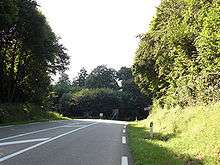Col de Saverne
The Col de Saverne (Pass of Saverne or Saverne Pass, German: Zaberner Steige) is a natural pass in the north of the Vosges mountains, near Saverne, which permits travel between the départements of Bas-Rhin and Moselle, and therefore between Alsace and Lorraine.[1]
Transport routes that traverse the Saverne Pass include national highway RN 4 and A4 autoroute A4, the Paris-Strasbourg railway, as well as the Marne-Rhine Canal.[2]

The area is noted for its botanical gardens, especially the Jardin Botanique de Saverne and the Roseraie de Saverne.
The Saverne Gap (French: trouée de Saverne) is a gorgelike passage that cuts through the Vosges from Arzviller to Saverne, following the course of the Zorn River for most of its length. The passage is barely 100 yards wide at some points.[3] It figured prominently into the advance of the U.S. XV Corps against German forces in the Second World War. The rapid traversal of the Saverne Gap resulted in a breakthrough by the French 2nd Armored Division, which subsequently liberated Strasbourg on November 23, 1944.
Notes
- The second main road out of Alsace is the Trouée de Belfort (Belfort Gap), linking the département of Haut-Rhin (Grand Est) to the département Territoire-de-Belfort, région Bourgogne-Franche-Comté. Alsace is also accessible via the Tunnel Maurice-Lemaire and some other vosgian passes but they are neither allowed to heavy truck traffic (and dangerous goods in the tunnel) nor equipped with railroads.
- Between 1797 and 1852, the Paris-Strasbourg optical telegraph line used this pass too.
- Clarke and Smith, Riviera to the Rhine, p. 366, Washington: Government Printing Office, 1993.